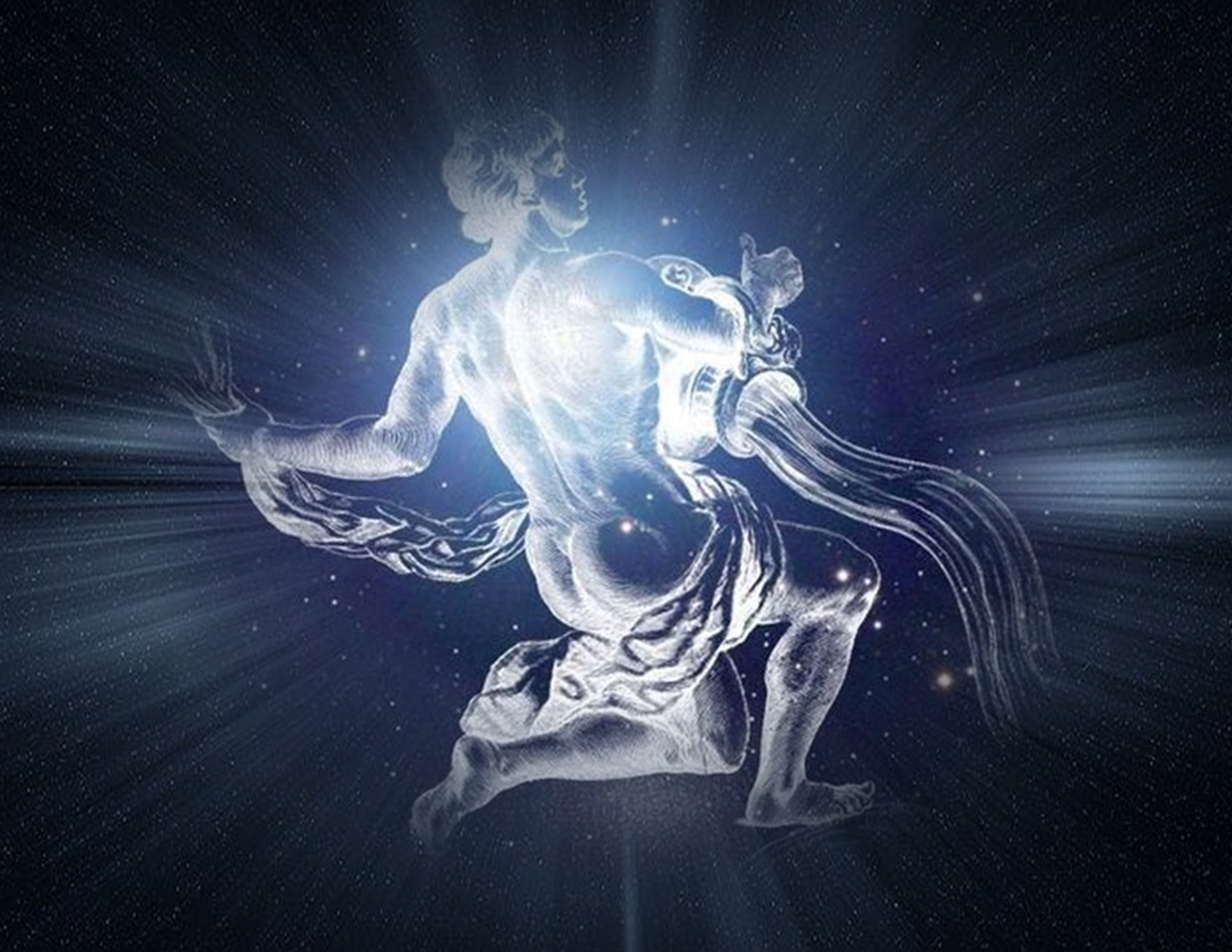 Submitted by Celesta Aquaria on
Submitted by Celesta Aquaria on

Derivative Images
Common sense and scholarly commentary by veteran astrologer Steven Forrest.
The fabled Age of Aquarius – does it mean anything at all? Ever since the musical Hair was first performed back in 1967, there has been a vague sense that the Aquarian Age had something to do with hippies or free love or world peace or . . . something.
Anyway, from that long-haired point of view, the Age of Aquarius probably ended about fifty years ago . . . unless you bring up the subject among a group of astrologers. Then what you will typically see has very little to do with “harmony and understanding, sympathy and trust abounding . . .” Then what you will typically see is closer to World War Three. Opinions on the subject of the astrological ages tend to be trenchant – and the general thrust of them usually runs down the road of claiming that the Age of Aquarius is real enough, but that it is still way off in the far distant future.
I disagree. I think we are in it now. I think we have been in it for over a century already.
In this newsletter I want to make my case that the Age of Aquarius dates back to 1903-1905.
Let’s start with Science Class.
Earth’s north pole describes a slow circle in the sky, sort of like a child’s spinning top winding down. This cycle – called the Precession of the Equinoxes – takes 25,771.5 years to go around once. As the north pole leans first this way, then circles around that way, naturally the position of the Celestial Equator shifts too. Tilt the child’s top and you can’t help but tilt the painted stripes on its sides as well.
At the Solstices, the Sun is maximally far north or south of the Celestial Equator, while at the Equinoxes, the Sun is aligned with it.
Remember: the Sun is always on the ecliptic – the Sun is what defines it.
Two and two makes four: at the Equinoxes, the Sun is where the Celestial Equator and the Ecliptic cross.
That point is slowly moving backwards, taking 25,771.5 years to return to where it started.
What all this boils down to is the fact that the Sun’s position on the first day of Spring (or the first day of Autumn) relative to the starry background is slowly precessing in retrograde fashion. Gradually it shifts from constellation to constellation. Four or five millennia ago, on the day of the northern Vernal Equinox, the Sun rose into the constellation Taurus. After some centuries, it began to rise into the constellation Aries, then into the constellation Pisces . . .
I emphasize “constellation” because constellations are different from signs. That, as we will see, is the key to the entire mystery.
We astrologers define “the first degree of Aries” as the position of the Sun on the day of the northern Vernal Equinox. Long ago, it aligned with the actual constellation of stars we call “Aries.” No longer. Here’s the whole thing in one sentence: Astrology, as most of us practice it in the West, is based on the seasons, not the stars. (Vedic astrologers and the Western siderealists use the constellations.)
Theoretically, defining the Ages is very simple: the “Age of Pisces” began when the Vernal Equinox left the constellation Aries and entered the constellation Pisces. And the Age of Aquarius began – or will begin – when it enters the constellation Aquarius.
Simple? Not exactly.
The question is, where exactly does the constellation Aquarius begin? Actually, when you think about it, all we have up in the sky is a bunch of stars. There are no boundaries around them. Different cultures have “connected the starry dots” differently. Constellations are folklore, not any kind of objective, measurable reality.
That fuzziness about constellation boundaries was an inconvenience for astronomers, which they solved by committee. The boundaries of the 88 official constellations were adopted by the International Astronomical Union in 1928 and published in 1930.
If we take the IAU to be the holy gospel of truth, the Vernal Equinox will enter Aquarius around the year 2600 A.D. By that standard, we are not even close to the dawning of the Age of Aquarius, so put away your guitars and your bell-bottom bluejeans.
As I mentioned earlier, many serious astrologers pooh-pooh the notion that we have already entered the Aquarian Age. Their argument is founded upon their great and unquestioning faith in the map of the sky that the International Astronomical Union published almost a century ago..
There are some problems with that kind of thinking however.
Have a look at this diagram:

https://www.forrestastrology.com
On the left, you can see the position of the Sun on the northern Vernal Equinox around 4500 years ago. Did it fall in Taurus or Aries? There is no actual boundary in the sky, but it “leans Taurus.” On the right, you’ll see the Sun’s Equinox position today – and it is still very much in the constellation Pisces.
Case closed? Again, many astrologers are adamant about that claim. Personally, I think that they are taking the International Astronomical Union too seriously. For one thing, if we follow the IAU’s lead scrupulously, we’ll need to add a thirteenth astrological sign – Ophiuchus. It is on the ecliptic too.
Back to our diagram. Note that the constellation Aries is tiny compared to Pisces. Constellations vary enormously in size. Virgo is the biggest zodiacal constellation by far. Capricorn is the smallest. But absolute astrological bedrock is the idea that all the signs are equal in size. Should we abandon that principle? Twelve equal divisions – that is the core of astrological geometry.
Nothing against the International Astronomical Union, but let’s try thinking like astrologers. Let’s take a leap and postulate that there are twelve equal “constellations” up there in the sky, each one 30̊ wide. I put “constellations” in quotation marks because we would no longer be thinking according to the IAU’s boundaries, nor would be bound to Eurocentric folk traditions about how to arrange these configurations of stars. These new “constellations” would not be our familiar signs of the zodiac either, although they’ll retain the same names.
Fine – but all this brings us back to our central problem: where does our “constellation” Aries begin? We still cannot see a mark in the sky.
Go back to astrological bedrock: “As above, so below” – but of course that also means “as below, so above.” Maybe if we can’t answer our question by looking at the sky, we can answer it by looking at human history. Astrology works; each one should reflect the other.
Twelve equal “constellations” would mean that each astrological Age would last for one-twelfth of 25,771.5 years. Each one would then be 2147.5 years long.
When did the Piscean Age begin? We can write volumes about Pisces, but let’s cut to the chase by simply thinking of it as the most mystical sign. Reasoning from history rather than from astronomy, we might arbitrarily split the difference between the births of the two great mystical Teachers, Buddha and Christ, born in approximately 563 and 4 BC respectively. (We might include Muhammad, but he was not born until much later, in 571 A.D.)
Using Gautama and Jesus, that would give us 283 BC for a wildly hypothetical guess about the start of the Piscean Age. This is obviously quick and dirty thinking! But let’s see where it leads us. We do know that sometime around then, we would also have been emerging from the Age of Aries – an epoch of bloody conquest, swords, and cities laid to waste. As Aries gave way to Pisces, it seems reasonable to speculate that people might be ready to hear from “the Prince of Peace.”
Aquarius in a nutshell? Limiting ourselves to one word as we did with Pisces, let’s say Aquarius represents genius. One might speculate that the outset of an Aquarian Age would be heralded by some startlingly brilliant, rule-breaking human innovations.
Adding 2147.5 years to 283 B.C. (and remembering that “A.D.” started with 1 A.D., not 0 AD), would yield 1865 for the hypothetical beginning of the Aquarian Age – presumably an Age of genius. But do recall that we arrived at our “283 B.C.” in very crude fashion. There is no compelling reason to be rigid about that date. If we had a good reason to shift it by a few decades, that would not be anything about which we should worry.
I personally like 1903-1905, just forty years or so later. That would coincide with the first powered airplane flight – the Wright Brothers taking off from Kitty Hawk on the Outer Banks of North Carolina on December 14, 1903. Humans learning to fly! Doesn’t that sound like an Aquarian rebellion against all limitations? Doesn’t that sound like a new level of human freedom? Doesn’t that ring of human genius?
I also like the publication of Einstein's Special Theory of Relativity on September 26, 1905.
Albert Einstein – just say the word genius and it takes most people under ten seconds to free-associate to his name. One could make a case that the Theory of Relativity is the greatest intellectual triumph in human history.
1903-1905 is not quite the same as 1865, but with Ages running over two millennia in length, forty years is only a drop in the bucket.
My favorite line here is that we went from Kitty Hawk to the Moon in 66 years.
Doesn’t that sound like the cusp of a new age? Doesn’t that sound like leaving the Age of Pisces and entering the Age of Aquarius?
Again, in all of this, we are reasoning from “below” to try to figure out what is going on “above.” We don’t know in any meaningful, confident way where the constellations start and finish – that’s our basic problem. So we turn our usual astrological methods on their heads. We look to events on earth to understand the sky. Reflecting on how the 20th century changed the elemental texture of human life makes a compelling argument that we are on the right track with this kind of thinking. And it of course goes way beyond airplanes and Einstein. Think of electricity, automobiles, the Internet . . . you know the list.
The implications for the global community moving out of the Age of Pisces and into the Age of Aquarius are vast. In this brief newsletter, I have only wanted to spell out the technical challenges we face in trying to decipher these mysteries – and to begin to make my case that we actually entered the Aquarian Age over a century ago.
- 472 reads